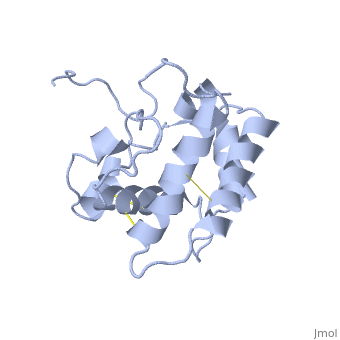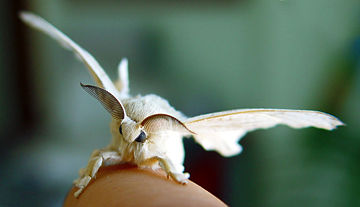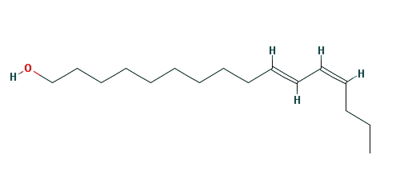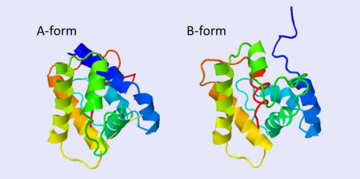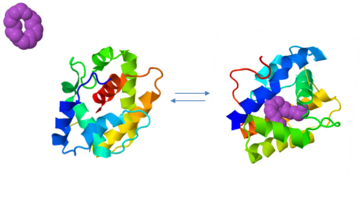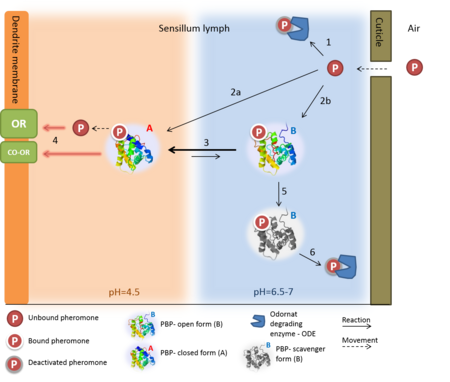Odorant binding protein
From Proteopedia
(Difference between revisions)
| (9 intermediate revisions not shown.) | |||
| Line 1: | Line 1: | ||
| + | <StructureSection load='1ls8' size='340' side='right' caption='Bombyx mori PBP (PDB code [[1ls8]])' scene=''> | ||
[[Image:Bombyx mori.jpg|thumb|upright=2|''Bombyx mori'', the silk moth, picture by [https://www.flickr.com/photos/depredator007/2522038240/ Fernando Cuenca]]] | [[Image:Bombyx mori.jpg|thumb|upright=2|''Bombyx mori'', the silk moth, picture by [https://www.flickr.com/photos/depredator007/2522038240/ Fernando Cuenca]]] | ||
| - | [[Image:Bombykol. | + | [[Image:Bombykol.jpg|400px|thumb|upright=1|Bombykol, a sex pheromone of ''Bombyx mori'', from [http://pubchem.ncbi.nlm.nih.gov/compound/Bombykol#section=Top PubChem]]] |
==Introduction== | ==Introduction== | ||
Odorant-binding protein (OBP) are soluble proteins which are involved in the processes of odorant detection in the olfactory sensilla <ref name="Pelosi 2014">doi: 10.3389/fphys.2014.00320</ref>. Though functionally the same, vertebrates and insects OBP have different origin and structure. | Odorant-binding protein (OBP) are soluble proteins which are involved in the processes of odorant detection in the olfactory sensilla <ref name="Pelosi 2014">doi: 10.3389/fphys.2014.00320</ref>. Though functionally the same, vertebrates and insects OBP have different origin and structure. | ||
OBPs are important for insect olfaction. For instance, OBP76a (LUSH) in the fly [http://en.wikipedia.org/wiki/Drosophila_melanogaster ''Drosophila melanogaster''] is required for the detection of the pheromone vaccenyl acetate <ref name="Xu 2005">doi: 10.1016/j.neuron.2004.12.031</ref> and has been proven to adopt a conformation that activates the odorant receptor <ref name="Laughlin 2008">doi: 10.1016/j.cell.2008.04.046</ref>. | OBPs are important for insect olfaction. For instance, OBP76a (LUSH) in the fly [http://en.wikipedia.org/wiki/Drosophila_melanogaster ''Drosophila melanogaster''] is required for the detection of the pheromone vaccenyl acetate <ref name="Xu 2005">doi: 10.1016/j.neuron.2004.12.031</ref> and has been proven to adopt a conformation that activates the odorant receptor <ref name="Laughlin 2008">doi: 10.1016/j.cell.2008.04.046</ref>. | ||
| + | |||
| + | For more details see [[Chemical communication in arthropods]]. | ||
== OBP Function == | == OBP Function == | ||
| Line 26: | Line 29: | ||
==''Bombyx mori'' BmorPBP (lets talk about sex..)== | ==''Bombyx mori'' BmorPBP (lets talk about sex..)== | ||
| - | + | ||
Pheromone binding proteins (PBPs) are specialized members of the insect odorant-binding protein (OBP) super-family. | Pheromone binding proteins (PBPs) are specialized members of the insect odorant-binding protein (OBP) super-family. | ||
The main purpose in the adult moth's short life is reproduction. In fact, the male and female moth invest all of their energy and resources hoping to reach to the ultimate goal- mating. This long journey begins when the female moth releases a sex pheromone, usually during specific hours in the night <ref>doi: 10.1007/BF01946910</ref>. | The main purpose in the adult moth's short life is reproduction. In fact, the male and female moth invest all of their energy and resources hoping to reach to the ultimate goal- mating. This long journey begins when the female moth releases a sex pheromone, usually during specific hours in the night <ref>doi: 10.1007/BF01946910</ref>. | ||
| Line 62: | Line 65: | ||
==Activation by the complex pheromone-PBP== | ==Activation by the complex pheromone-PBP== | ||
An alternative mode of action was proposed for the receptor activation in ''Drosophila melanogaster'', where it was found that the complex of pheromone-PBP is required for the activity of pheromone-sensitive neurons <ref>DOI: 10.1016/j.neuron.2004.12.031</ref><ref>doi: 10.1016/j.cell.2008.04.046</ref> | An alternative mode of action was proposed for the receptor activation in ''Drosophila melanogaster'', where it was found that the complex of pheromone-PBP is required for the activity of pheromone-sensitive neurons <ref>DOI: 10.1016/j.neuron.2004.12.031</ref><ref>doi: 10.1016/j.cell.2008.04.046</ref> | ||
| - | + | ||
==3D structure of odorant binding protein== | ==3D structure of odorant binding protein== | ||
| + | [[Odorant binding protein 3D structures]] | ||
| - | + | </StructureSection> | |
| - | + | ||
| - | + | ||
| - | + | ||
| - | + | ||
| - | + | ||
| - | + | ||
| - | + | ||
| - | + | ||
| - | + | ||
| - | + | ||
| - | + | ||
| - | + | ||
| - | + | ||
| - | + | ||
| - | + | ||
| - | + | ||
| - | + | ||
| - | + | ||
| - | + | ||
| - | + | ||
| - | + | ||
| - | + | ||
| - | + | ||
| - | + | ||
| - | + | ||
| - | + | ||
| - | + | ||
| - | + | ||
| - | + | ||
| - | + | ||
| - | + | ||
| - | + | ||
| - | + | ||
| - | + | ||
| - | + | ||
== See also == | == See also == | ||
| Line 109: | Line 78: | ||
== References == | == References == | ||
<references/> | <references/> | ||
| + | [[Category:Topic Page]] | ||
Current revision
| |||||||||||
See also
- Odorant_binding_protein_3D_structures
- Chemical communication in arthropods
- Pheromone binding protein
- Bovine odorant binding protein
References
Proteopedia Page Contributors and Editors (what is this?)
Nurit Eliash, Michal Harel, Joel L. Sussman, Alexander Berchansky, Jaime Prilusky
